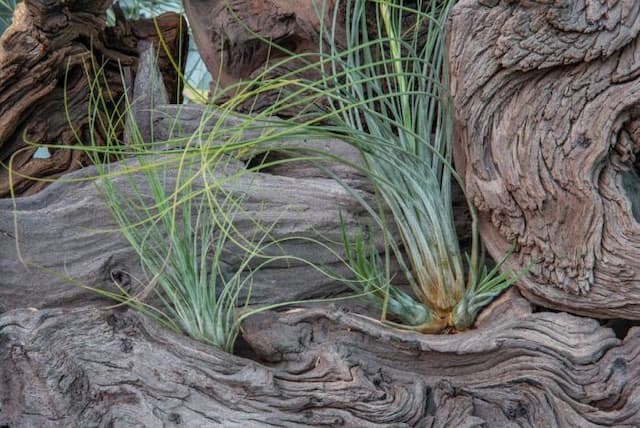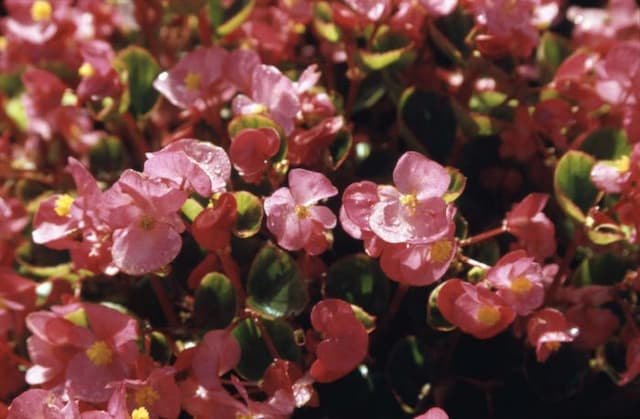Begonia Begonia 'Rocheart' (R)

ABOUT
The Begonia 'Rocheart' is an ornamental plant known for its stunning foliage and flowers. The leaves are possibly its most striking feature; they display a rich array of colors, often with a metallic sheen. Shades of green, red, purple, or silver may be present, and the surface of the leaves could have a unique textured appearance, with a pebbled or quilted effect. The leaf shape is typically asymmetrical, and the edges can be ornately wavy or edged with delicate serrations, giving the foliage a ruffled look. The flowers of the Begonia 'Rocheart' are delicate and vary in color, often blooming in shades of pink, white, or red. They may appear in clusters or individually and often dangle or rise above the foliage, adding an extra layer of beauty to the plant. The blooms can have a simplistic charm with a fleshy, petal-like quality, exuding a soft, subtle fragrance on occasion. This rounded plant bears a bushy appearance due to its dense growth of leaves and flowers, creating a lush, full look that can add a gentle pop of color and texture to the environment in which it is placed. Overall, the Begonia 'Rocheart' is prized for its decorative appeal, owing to its lovely combination of vibrant leaves and flowers.
About this plant
 Names
NamesFamily
Begoniaceae.
Synonyms
No common names available.
Common names
Begonia 'Rocheart' (R).
 Toxicity
ToxicityTo humans
Begonias, including the Begonia 'Rocheart', are known to contain compounds that can be toxic when ingested by humans. If eaten, the most common symptoms may include irritation of the mouth, lips, and throat, as well as gastrointestinal discomfort such as nausea, vomiting, and diarrhea. In some cases, it can also lead to kidney irritation. It is important to avoid consuming any part of the plant and to keep them out of reach of children who might accidentally ingest them.
To pets
Begonias, including the Begonia 'Rocheart', are also toxic to pets such as dogs and cats. Ingesting any part of the plant can cause similar symptoms as in humans, including oral irritation, excessive drooling, vomiting, and difficulty swallowing. Pets might also experience signs of gastrointestinal upset. It is recommended to keep these plants away from pets to prevent accidental ingestion. If you suspect your pet has ingested begonia, contact a veterinarian promptly.
 Characteristics
CharacteristicsLife cycle
Perennials
Foliage type
Evergreen
Color of leaves
Varies
Flower color
Pink
Height
1-1.5 feet (30-45 cm)
Spread
1-1.5 feet (30-45 cm)
Plant type
Herb
Hardiness zones
10
Native area
Hybrid origin
Benefits
 General Benefits
General Benefits- Ornamental Appeal: Begonia 'Rocheart' offers vibrant colors and unique foliage patterns that beautify gardens and indoor spaces.
- Low Maintenance: It is known for being relatively easy to care for, requiring minimal upkeep once the appropriate growing conditions are met.
- Versatility: This plant can thrive in a variety of settings, including containers, hanging baskets, and garden beds.
- Shade Tolerance: Begonia 'Rocheart' can grow in shaded areas where other plants may not, making it ideal for spots with less direct sunlight.
- Long Blooming Period: It produces flowers for an extended period, which can last from spring through fall in the right climate.
- Drought Resistance: Once established, it can tolerate short periods of drought, making it suitable for drier climates or water-wise gardens.
 Medical Properties
Medical PropertiesThis plant is not used for medical purposes.
 Air-purifying Qualities
Air-purifying QualitiesThis plant is not specifically known for air purifying qualities.
 Other Uses
Other Uses- Begonias like 'Rocheart' can be used as a natural dye source. The flowers and leaves may be boiled to extract color for fabric or craft dyeing.
- When dried and pressed, begonia flowers are perfect for creating botanical art pieces like bookmarks, greeting cards, or framed nature displays.
- Certain begonias are edible and can be used in salads to add a splash of color and a slightly sour taste, although it's important to ensure that the specific variety is safe for consumption.
- The waxy leaves can be used as molds for creative projects such as making candles or soaps that take on the intricate leaf vein patterns.
- Begonia petals can serve as a natural confetti for celebrations, offering a biodegradable and eco-friendly alternative to synthetic confetti.
- In craft terrariums or fairy gardens, small begonia plants can be used to add a sense of lush, miniature landscapes.
- The plant's ability to thrive in high humidity conditions makes it suitable for decorating bathroom spaces where other plants might not survive.
- Some cultures use specific types of begonias in traditional ceremonies for their symbolism and beauty, though this can vary widely from one community to another.
- As a natural indicator plant, some begonias can be used by gardeners to gauge the moisture level in the environment, as their leaves will droop when lacking water.
- Begonia foliage can be used in creative table settings or gift wrapping, providing a fresh and natural decorative element.
Interesting Facts
 Feng Shui
Feng ShuiThe Begonia is not used in Feng Shui practice.
 Zodiac Sign Compitability
Zodiac Sign CompitabilityThe Begonia is not used in astrology practice.
 Plant Symbolism
Plant Symbolism- Caution: Begonias in general symbolize caution, due to their delicate nature. They serve as a reminder to be wary in new situations.
- Harmony: The balanced growth and appearance of the Begonia 'Rocheart' can represent harmony in life, symbolizing balance and peace.
- Gratitude: The Begonia is often given as a token of thanks; thus, it symbolizes gratitude and appreciation for others.
- Individuality: With its unique foliage and form, the Begonia can symbolize uniqueness and encourage us to embrace our personal differences.
- Friendship: Sometimes Begonias represent deep friendship and camaraderie, exemplified through the interconnected growth of their leaves and stems.
 Water
WaterAngel wing begonia should be watered thoroughly once the top inch of the soil feels dry to the touch. Depending on the environmental conditions, this might be approximately once a week. It's crucial to let the water run through the drainage holes and discard any excess from the saucer, as standing water can lead to root rot. Use room temperature water, and during the growing season, from spring through summer, water with about 16 ounces each time for a standard pot size. In cooler months, reduce watering frequency but never allow the soil to become completely dry.
 Light
LightAngel wing begonia thrives in bright, indirect light; direct sunlight can scorch the leaves. A north-facing or east-facing window is ideal, providing the gentle morning light and avoiding the harsh afternoon sun. If you only have a south or west-facing window, use a sheer curtain to diffuse the intense sunlight.
 Temperature
TemperatureAngel wing begonias prefer temperatures between 65 and 75 degrees Fahrenheit. They can survive in temperatures as low as 60 degrees Fahrenheit but should not be subjected to temperatures below 50 degrees Fahrenheit as they are not cold tolerant. The ideal temperature range promotes healthy growth and flowering.
 Pruning
PruningPrune angel wing begonia to encourage bushier growth and to remove any dead or yellowing leaves. The best time for pruning is in spring or early summer, which allows the plant to recover and grow more vigorously throughout its active growing season. Typically, it's sufficient to prune once a year, but you can also lightly prune as needed to shape the plant.
 Cleaning
CleaningAs needed
 Soil
SoilBegonias prefer a well-draining soil mixture that is rich in organic matter. A recommended mix for Begonia 'Rocheart' would be one part potting soil, one part peat moss, and one part perlite or coarse sand. The pH level ideal for Begonias is slightly acidic to neutral, ranging from 5.5 to 7.0.
 Repotting
RepottingThe Begonia 'Rocheart' should be repotted every 1-2 years or when it becomes root-bound. The best time to repot is in the spring or early summer.
 Humidity & Misting
Humidity & MistingBegonia 'Rocheart' thrives in high humidity levels, ideally between 50% and 70%. Avoid overly dry air which can cause leaf drop and edge browning.
 Suitable locations
Suitable locationsIndoor
Place near bright window; avoid direct sun; high humidity.
Outdoor
Partial shade, protect from frost, high humidity area.
Hardiness zone
10-11 USDA
 Life cycle
Life cycleBegonia 'Rocheart' begins its life cycle as a seed, which upon germination in warm, moist soil develops into a small seedling. The seedling grows into a vegetative plant with characteristic asymmetrical begonia leaves and starts to form a tuber-like structure at its base. As the plant matures, it enters the flowering stage, producing distinctive pink or red flowers that attract pollinators and can also reproduce through leaf cuttings or division. After pollination, the flowers will produce seeds that can be dispersed to grow new plants. Begonia 'Rocheart' may enter a dormancy period in response to colder temperatures or seasonal changes, during which growth slows down or stops and the plant conserves energy. With the return of favorable conditions, the plant exits dormancy, resumes active growth, and the cycle repeats.
 Propogation
PropogationPropogation time
Spring-Summer
The Begonia 'Rocheart', often simply referred to as Begonia, can be propagated effectively through leaf cuttings. This method is especially popular due to its simplicity and the high success rate. To propagate a Begonia 'Rocheart' using leaf cuttings, choose a healthy, mature leaf and cut it into sections, each containing at least one vein. Dust the cut edges with rooting hormone to encourage root growth. Then, place the leaf cuttings on moist potting soil, ensuring that the vein touches the soil. Cover the container with plastic to maintain humidity and place it in indirect light. Roots will typically develop within a few weeks, after which new shoots will emerge, allowing for the cultivation of new plants.








![Begonia [Allure]](/_next/image?url=https%3A%2F%2Fplants-admin.emdemapps.com%2Fimages%2Fplants%2F%2Fimages%2F604b5b9006ab9.png&w=640&q=75)
